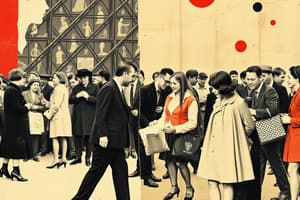Podcast
Questions and Answers
What pattern is shown by official statistics regarding crime?
What pattern is shown by official statistics regarding crime?
- Upper-class people offend more than working-class people.
- Crime rates are equal across all social classes.
- Working-class people are less likely to offend.
- Working-class people are more highly represented among offenders. (correct)
What percentage of inmates had no educational qualifications according to Omolade (2014)?
What percentage of inmates had no educational qualifications according to Omolade (2014)?
43%
What is the link between crime and poverty?
What is the link between crime and poverty?
Higher crime rates are often associated with conditions of poverty.
What does Merton's strain theory suggest about deprived communities?
What does Merton's strain theory suggest about deprived communities?
True or False: Control theory suggests that socialization weakens in disadvantaged communities.
True or False: Control theory suggests that socialization weakens in disadvantaged communities.
What focus does Marxist theory have regarding crime?
What focus does Marxist theory have regarding crime?
How does Becker's labelling theory apply to working-class individuals?
How does Becker's labelling theory apply to working-class individuals?
Which of the following factors can lead to higher crime rates in working-class areas?
Which of the following factors can lead to higher crime rates in working-class areas?
What assumption do right realist theories make about young men?
What assumption do right realist theories make about young men?
How has globalization affected the working class according to postmodern theories?
How has globalization affected the working class according to postmodern theories?
Flashcards are hidden until you start studying
Study Notes
Social Class and Crime
- Working-class individuals, particularly from lower socioeconomic backgrounds, are more frequently represented among offenders according to official statistics.
Omolade (2014) Findings
- Of 2100 inmates surveyed:
- 43% lack educational qualifications.
- Only 6% possess a degree or equivalent.
- 36% were unemployed at the time of sentencing.
- 60% were receiving government benefits.
Social Deprivation and Crime
- A strong link exists between crime rates and poverty, particularly with property crimes.
- Gordon (1976) described capitalism as criminogenic, encouraging greed and selfish behavior.
- Lea and Young (1984) emphasize that deprivation is perceived relatively based on societal expectations.
Strain Theory and Anomie
- Merton's (1968) theory posits that deprivation limits opportunities to achieve societal goals, leading individuals to resort to innovative (often criminal) means to attain success.
Marginality and Social Exclusion
- Disadvantaged communities experience heightened marginality and social exclusion.
- Weaker socialization and control mechanisms in these areas increase vulnerability to crime.
- Rational choice theory suggests that individuals may see the benefits of crime, such as financial gain, as outweighing the risks involved.
Marxist Theory
- The focus of society is skewed toward working-class crime, neglecting middle-class offenses.
- Legal systems are perceived to disproportionately punish working-class individuals.
- Criminogenic capitalism contributes to the deprivation experienced by the working class.
Interactionalist Theories
- Media and criminal justice control by the middle class leads to misrepresentation of working-class behavior.
Cicourel's Research
- Middle-class parents are more adept at navigating the justice system, resulting in lower crime rates among middle-class youth.
Becker's Labelling Theory
- Working-class individuals are often labeled as criminals more readily, attracting increased police scrutiny.
Labelling, Stereotyping, and Prejudice
- Poorer working-class communities often fit police stereotypes of criminality.
- Heightened police presence in these areas leads to more frequent stops, searches, and arrests.
- Working-class individuals face a higher likelihood of being judged as typical criminals, resulting in harsher treatment through the legal system.
Right Realist Theories
- The existence of a criminal underclass, often typified by "idle young men," is attributed to flawed socialization in lone-parent families (Murray).
- Broken Windows Theory suggests that deteriorating neighborhoods correlate with increased criminal behavior.
- For working-class criminals, the perceived cost of crime is lower, leading to a higher likelihood of engaging in criminal activities.
Postmodern Theories
- Globalization has disproportionately impacted the working class, with the outsourcing of manual labor leading to unemployment.
- This crisis of masculinity positions crime as an appealing career choice and a source of status that has been lost in traditional roles.
Studying That Suits You
Use AI to generate personalized quizzes and flashcards to suit your learning preferences.




